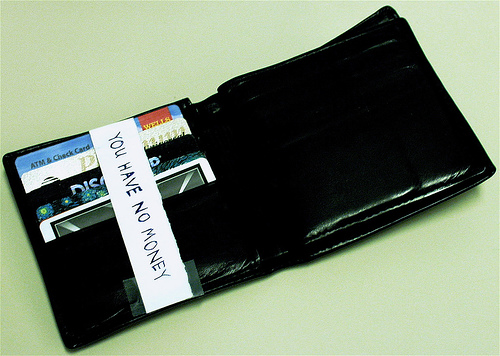- RT @ScottATaylor: Get a Daily Summary of Your Friends’ Twitter Activity [FREE INVITES] http://bit.ly/4v9o7b #
- Woo! Class is over and the girls are making me cookies. Life is good. #
- RT @susantiner: RT @LenPenzo Tip of the Day: Never, under any circumstances, take a sleeping pill and a laxative on the same night. #
- RT @ScottATaylor: Some of the United States’ most surprising statistics http://ff.im/-cPzMD #
- RT @glassyeyes: 39DollarGlasses extends/EXPANDS disc. to $20/pair for the REST OF THE YEAR! http://is.gd/5lvmLThis is big news! Please RT! #
- @LenPenzo @SusanTiner I couldn’t help it. That kicked over the giggle box. in reply to LenPenzo #
- RT @copyblogger: You’ll never get there, because “there” keeps moving. Appreciate where you’re at, right now. #
- Why am I expected to answer the phone, strictly because it’s ringing? #
- RT: @WellHeeledBlog: Carnival of Personal Finance #235: Cinderella Edition http://bit.ly/7p4GNe #
- 10 Things to do on a Cheap Vacation. https://liverealnow.net/aOEW #
- RT this for chance to win $250 @WiseBread http://bit.ly/4t0sDu #
- [Read more…] about Twitter Weekly Updates for 2009-12-19
How You’re Finding Me
Every once in a while, I like to dig through Google Analytics and see how people are finding this site. Some of the search terms are interesting.
“father of three” mid life crisis
Here’s a free piece of advice. As a father of three, you don’t get to have a mid-life crisis. It’s not allowed. Rather, it’s allowed, but you aren’t allowed to act on it. At a minimum, until your children are out of the house, you need to man up and provide all of the support you possibly can. No sports cars you can’t afford and no 22 year old hardbodies. Be there for your kids.
“payday loans” which accepts guest posts
Payday loan marketing. Just go away. You aren’t running a guest post here.
“slow carb” hungry all the time
You’re doing it wrong. If you are hungry, eat more bacon. Or beans. Beans fill you up longer.
$1000000 business idea
Ideas are the easy part. Execution makes you a millionaire.
articles on why appearance shouldn’t matter?
Appearances do matter, and always will. Your appearance is what makes the initial impression when you meet someone new. You don’t have to be a model, but basic grooming and fashion sense is necessary. Take this with a grain of salt. I’ve got a week’s growth of a beard and I wear a different plaid, button-down shirt every day.
are push ups supposed to be hard
Only the first 50. After that, I kind of go on blissed-out autopilot. If you can do 100 pushups, you can probably do 200.
acceptable place to put tattoo
If you wear clothes there, you can put a tattoo there. Visible tattoos are called “job stoppers” for a reason. If you put a tattoo on your face, the only job you qualify for is “drug dealer’s girlfriend”. Or possibly prison janitor.
burning bridges with toxic people
If you must burn bridges, filling them with toxic people first isn’t a bad idea.
candied pork butt
Rule 34: If it exists, there is porn of it. Interesting side story: while double-checking the rule number, I stumbled across My Little Ponies doing things they never advertise on the box.
cut my wife’s hair
I did this once. Pro tip: In the back, at the bottom, cut small chunks and leave them longer than you think they should be. You can always cut more, but uncutting hair is really hard.
f***** on the roadside by your mechanic
He probably deserves a tip for that.
girls fart for money and girls live farts
See the bit about the pork butt, remove the funny, and…ewww.
how to be a successful debtor
I recommend starting by paying your bills. When the debts are gone, you win. Success!
i ate bacon on slow carb diet
So did everyone else, sweetie. It’s the biggest draw to the slow carb diet.
in memory of pets tattoos
When I get a pet, I get it with the understanding that I’m going to outlive it. The day I bring it home, some small part of me is preparing for the day when I have to dig a hole in my backyard. Tattooing that day? Not gonna happen.
thickening felt behind testicle
Why are you on google? Go to the doctor. Please?
Interesting. Between girls farting and my post about being well-trained, there is a significant amount of fetish traffic coming through here. Maybe I need to explore a new advertising strategy.
My Financial Plan – How I Improve on Ramsey
In April, my wife and I decided that debt was done. We have hopefully closed that chapter in our lives. I borrowed, then purchased, The Total Money Makeover by Dave Ramsey.  budget” width=”300″ height=”213″ />We are almost following his baby steps. Our credit has always been spectacular, but we used it a lot. Our financial plan is Dave Ramsey’s The Total Money Makeover, with some adjustments.
budget” width=”300″ height=”213″ />We are almost following his baby steps. Our credit has always been spectacular, but we used it a lot. Our financial plan is Dave Ramsey’s The Total Money Makeover, with some adjustments.
Step 1. Budget:
The budget was painful, and for the first couple of months, impossible. We had no idea what bills were coming due. There were quarterly payments for the garbage bill and annual payments for the auto club. It was all a surprise. Surprises are setbacks in a budget.
When something came up, we’d start budgeting for it, but stuff kept coming up. We’re not on top of all of it, yet, but we are so much closer. We’ve got a virtual envelope system for groceries, auto maintenance, baby needs(we have two in diapers) and some discretionary money. We set aside money for everything that isn’t a monthly expense, and have a line item for everything that is. My wife is eligible for overtime and monthly bonuses. That money does not get budgeted. It’s all extra and goes straight on to debt, or to play catch-up with the bills we had previously missed. I figure it will take a full year to get all of the non-monthly expenses in the budget and caught up.
Step 2. The initial emergency fund:
Ramsey recommends $1000, adjusted for your situation. I decided $1000 wasn’t enough. That isn’t even a month’s worth of expenses. We settled on $1800, plus $25/month. It’s still not enough, but it’s better. Hopefully, we’ll be able to ignore it long enough that the $25/month accrues to something worthwhile.
Step 3. The Debt Snowball:
This is the controversial bad math. Pay off the lowest balance accounts first, then take those payments and apply them to the higher balance accounts. Emotionally, it’s been wonderful. We paid off the first credit card in a couple of weeks, followed 6 weeks later by my student loan. Since April, we’ve dropped nearly $10,000 and we haven’t made huge cuts to our standard of living. At least monthly, we re-examine our expenses to see what else can be cut.
Step 4. Three to six months of expenses in savings:
We aren’t on this step yet. In step 2, we are consistently depositing more, making us more secure every month.
Step 5. Invest 15% of household income into Roth IRAs and pre-tax retirement:
I have not stopped my auto-deposited contribution. It’s stupid to pass up an employer match. My wife’s company does not match, so she is currently not contributing.
Step 6. College funding for children:
We have started a $10 College fund.
Step 7. Pay off home early:
I don’t see the point in handling this one separately. Our mortgage is debt, and when the other debts are paid, we will be less than a year from owning our house, free and clear. This is rolled in with step three. All debt is going away, immediately.
Step 8. Build wealth and give!
We have cut off most of our charitable giving. Every other year, it has been a significant percent of our income, and in a few more years, will be so again. The only exception to this is children knocking on the door for fundraisers. I have no problems with saying no to a parent fundraising for their kid, but when the kids is doing the work, door-to-door, especially in the winter, I buy something. My son’s school, on the other hand, gets fundraisers ignored. When they come home, I send a check to the school, ignoring the program. I bypass the overhead and make a direct donation.
What Is Your Binary Options Strategy?
 When you are just entering the world of binary options trading or investing, you may be on the receiving end of a lot of advice. It is not uncommon to hear people tell you to implement different gambling strategies because binary options are based on chance more than anything else. You will also hear a lot of advice from those who say there are many good ways to develop an effective strategy using indicators and market signals. Some will insist that with proper analysis of market data, a solid strategy can be developed too.
When you are just entering the world of binary options trading or investing, you may be on the receiving end of a lot of advice. It is not uncommon to hear people tell you to implement different gambling strategies because binary options are based on chance more than anything else. You will also hear a lot of advice from those who say there are many good ways to develop an effective strategy using indicators and market signals. Some will insist that with proper analysis of market data, a solid strategy can be developed too.
Are they all correct? Interestingly enough, the answer is yes. The reason for this is simple, and as one expert writes, “there is no such thing as a perfect strategy for every trader. There is only a best strategy for each individual trader.” Thus, your strategy has to be shaped around a few things:
- Your willingness and ability to follow your chosen strategy.
- Your personality. For instance, are you restless if you are taking the safe route or a higher risk strategy?
- Your budget and goals,
Identifying the answers to these questions is the first step to formulating a strategy. You should also understand that the winning percentage of most strategies will be somewhat constant, but the total number of successful trades varies on an individual basis and is based entirely on the strategies used.
For instance, some investors want a high percentage of winning trades and are more comfortable with risk averse trading. Others are ready to take more risk and are entirely comfortable winning fewer trades if the returns on winning trades are dramatically higher. This enables them to implement higher risk trades. The interesting thing about strategies and the kinds of trades they generate is that they are all built from the same data.
The Data of Strategy
For example, almost all strategies will look at issues like market trends, trading trends, highs and lows, reversals, and various kinds of indicators. The reason that high and low trends pay off in strategy development is simple: binary options trading applies to whether or not an asset rises above a strike price or doesn’t. It is the proverbial “yes or no” part of the proposition and analysis for either outcome pays off.
As an example, a lot of risk-averse investors will look for breakouts. They use these for trend line investing, which can be as brief as sixty seconds to a day, but can be used to coordinate investing in the direction of a short trend. Although this seems complex, it really is not. The key is that analysis cannot be broad and across all available markets. Instead, focused analysis on a specific area will allow even a novice investor to analyze for a breakout and then invest in binary options accordingly.
Just being able to detect a reversal or a downward trend over the course of a day can yield a very rewarding investment. The key is to understand your strategy based on your budget, personality, and your ability to stick with the strategy, even if it does not yield immediate success. When you do this, and use the right tools for analysis, you can create an effective strategy that brings you closer to your goals.
This is a guest post.
The Tax Man Cometh

- Image by brianjmatis via Flickr
Is the IRS after you? Did you forget to file your tax returns for the last 10 years? Are you worried that they are going to seize your bank accounts, leaving you broke and unable to finance your latest Pokemon acquisition?
There are many reasons people neglect to file their tax returns. None of the reasons are good. The usual reason is that you know you’ll owe money you can’t afford to pay, so you wrap yourself in denial and attempt to delay the inevitable. For future reference, the government always wins. Not filing is a temporary solution at best, and a really bad one at that. Not paying just guarantees that you will owe more penalties than if you had filed and gotten on a repayment plan. Avoiding your tax return will come back to haunt you eventually.
If you haven’t filed your tax returns, you need to do so as soon as possible. The longer you wait, the fewer options you have and the more likely the account seizures. Keep your money under your own control. Another problem with not filing is that the IRS will estimate your tax debt. The estimate is always in their favor. If you file, you get to list your deductions. If you don’t file, they give you the standard deduction and ignore almost everything in your favor. In some cases, this can mean they think you owe $10,000 when in reality, if you file, you will only possibly owe $1500.
To get started, you need to do is call the IRS at (800) TAX-1040. This call serves three purposes.
First, you need to confirm which years you need to file. Simply ask for the last year in which you have filed.
Second, request a transcript of all of your 1099s and W-2s. These are the forms that your employers, investments, and banks have sent to the IRS detailing your income. Over the years, it’s easy to lose paperwork, so this will ensure that you’re records match theirs. Depending on the time of the year, you should have the files in under a week. You’ll get one per delinquent year.
Third, this call gives you a chance to get on the “good debtor” list. You may have to get transferred to the collections department, but make sure you get someone to update your file with the fact that you are making good on your taxes. They will probably give you 30 days to file. Treat this as a hard deadline.
[ad name=”inlineleft”]Now that you have all of your paperwork, it’s time for the long slog. You have to do several years worth of returns, generally in one or two sittings. You can usually find back years of Turbo Tax on Amazon for cheap. As of this writing, the back years are under $10 per year. While you are filing, please keep in mind any charitable donations or business expenses you may have had. If you are missing a receipt for a major business purchase, never fear! The IRS does accept reasonable alternatives. I know of one case of an individual writing a letter to the IRS that read:
To Whom it May Concern:
Please accept this letter as a receipt for the purchase of a snowplow in the amount of $3000.
If you do this, you had better be able to back it up with the existence of an actual snowplow.
After you prepare your returns, look at the amounts you owe. You can only collect a refund for the last three years. If you owe more than you can afford to pay, you have two option, payment plans or settlement.
Payment plans involve delayed or continual payments. From IRS.gov:
Request an Extension of Time to Pay — Based on the circumstances, a taxpayer could qualify for an extension of time to pay. The IRS is willing to allow extensions of time to pay in order to assist in tax debt repayment. A taxpayer can request an extension from 30 to 120 days depending on the specific situation. Taxpayers qualifying for an extension of time to pay of 30 to 120 days generally will pay less in penalties and interest than if the debt were repaid through an installment agreement. Taxpayers can request an extension of time to pay using the Online Payment Agreement option available on thisWeb site.
- Apply for an Installment Agreement — The IRS may allow taxpayers to pay any remaining balance in monthly installments through an installment agreement. Taxpayers who owe $25,000 or less may apply for a payment plan electronically, using the Online Payment Agreement application. Alternatively, taxpayers may attach a Form 9465, Installment Agreement Request, to the front of their tax return. Taxpayers must show the amount of their proposed monthly payment and the date they wish to make their payment each month. The IRS charges a $105 fee for setting up an installment agreement. The fee is reduced to $52 for those who establish a direct debit installment agreement and $43 for those with an income below a certain level (for more information, see Form 13844). Taxpayers are required to pay interest plus a late payment penalty on the unpaid taxes for each month or part of a month, after the due date that the tax is not paid. A taxpayer who does not file the return by the due date — including extensions — may have to pay a failure-to-file penalty.
The IRS must accept your payment plan if your tax debt is under $10,000 and your proposed plan will pay it off within three years.
The other option is a settlement, or Offer in Compromise. Generally, only 10-15% of such offers are accepted. The IRS will rarely accept the off if they feel they can collect the debt for less than the amount owed. Don’t believe the guys on TV who pretend it is an effortless solution. From IRS.gov, the three acceptable reasons for OIC are as follows:
1. Doubt as to Collectibility – Doubt exists that the taxpayer could ever pay the full amount of tax liability owed within the remainder of the statutory period for collection.
Example: A taxpayer owes $20,000 for unpaid tax liabilities and agrees that the tax she owes is correct. The taxpayer’s monthly income does not meet her necessary living expenses. She does not own any real property and does not have the ability to fully pay the liability now or through monthly installment payments.
2. Doubt as to Liability – A legitimate doubt exists that the assessed tax liability is correct. Possible reasons to submit a doubt as to liability offer include: (1) the examiner made a mistake interpreting the law, (2) the examiner failed to consider the taxpayer’s evidence or (3) the taxpayer has new evidence.
Example: The taxpayer was vice president of a corporation from 2004-2005. In 2006, the corporation accrued unpaid payroll taxes and the taxpayer was assessed a trust fund recovery penalty as a responsible party of the corporation. The taxpayer was no longer a corporate officer and had resigned from the corporation on 12/31/2005. Since the taxpayer had resigned prior to the payroll taxes accruing and was not contacted prior to the assessment, there is legitimate doubt that the assessed tax liability is correct.
3. Effective Tax Administration – There is no doubt that the tax is correct and there is potential to collect the full amount of the tax owed, but an exceptional circumstance exists that would allow the IRS to consider an OIC. To be eligible for compromise on this basis, a taxpayer must demonstrate that the collection of the tax would create an economic hardship or would be unfair and inequitable.
Example: Mr. & Mrs. Taxpayer have assets sufficient to satisfy the tax liability and provide full time care and assistance to a dependent child, who has a serious long-term illness. It is expected that Mr. and Mrs. Taxpayer will need to use the equity in assets to provide for adequate basic living expenses and medical care for the child. There is no doubt that the tax is correct.
If you have a settlement accepted, you have three options for payment. A lump-sum payment must be paid in 5 installments or less, a short-term payment plan may be paid over 2 years, and the long-term repayment option has no set payment. Each of these options must meet differing levels of potential repayment, including figuring your real assets(your house and investments). In addition, you must include a non-refundable first payment and a $150 application fee when you apply for the settlement.
No matter which option you take, you can’t run from government debt. It will catch up to you and that will always be more painful that dealing with it on your own terms.
Update: This post has been included in the Carnival of Personal Finance.
Bribes vs Rewards

What’s the difference between a bribe and a reward? It’s a question that has been heavily on my mind lately. As a father of three–1, 3 and 10–motivating children occupies a lot of my thoughts. Is it possible to motivate a child and reward good behavior without resorting to a bribe?
First, let’s look at the definitions:
bribe n.
1. Something, such as money or a favor, offered or given to a person in a position of trust to influence that person’s views or conduct.
2. Something serving to influence or persuade.
re·ward n.
1. Something given or received in recompense for worthy behavior or in retribution for evil acts.
2. Money offered or given for some special service, such as the return of a lost article or the capture of a criminal.
3. A satisfying return or result; profit.
4. Psychology: The return for performance of a desired behavior; positive reinforcement.
In my mind, a reward is given either as a goal for planned activity or a surprise for good behavior. When used for surprises, it should never be common enough to be expected. If a child is only behaving because she is expecting a reward, it is bribed behavior. She should always be surprised to get the reward.
Using a reward for goal setting is no different than collecting a paycheck. Is my company bribing me to do the work I do every day? They plan to reward or compensate me for the work I plan to do for them. While that my be blurring the line between compensation and rewards, it is valid. My future paycheck is the motivation for my current work.
Bribes, on the other hand, are reward for bad behavior. If my three-year-old is throwing a tantrum in the grocery store and I promise her candy to stop, I have just taught her that the “reward” for a public tantrum is candy. This is reinforcing negative behavior, which will only escalate in the future. If a temper tantrum earns a candy bar, what will she get for hitting Mommy with a frying pan?
The line is further blurred by preemptive bribes. If I tell my children there will be candy when we get home if they behave in the store, it’s still a bribe. Promising dessert if my son cleans his room is a bribe.
So what is the difference?
Bribes reward negative behavior. Whether that is actual behavior or anticipated behavior, bribes provide a reward for it. If you use a treat to end or preempt bad actions, you are bribing your child.
Rewards celebrate positive behavior. A promised treat for going beyond expectations or a surprise for excellent behavior is a reward. It should never become common, or the child will discover that withholding the positive behavior will generate promises of larger rewards. The goal is to reinforce the good to encourage positive behaviors even when there is no likelihood for reward.
For example, my son’s school is part of a reading contest. Over a two month period, if the students read 500 pages outside of school, they will get tickets to a basketball game. If they are in the top three for pages read, they will get personalize jerseys and on-court recognition. My son did the math and was reading enough to surpass the 500 page goal, but not enough to get into the top three. I offered a prize if he made it to 2500 pages. In my opinion, that’s a reward. He was already going beyond the requirement. I have provided motivation to push himself beyond what he thinks he can do. That’s positive reinforcement of good behavior.
On the other hand, when my eight-year-old was refusing to eat dinner, we offered a cookie for dessert if she ate well. That’s reinforcing negative behavior by giving a reward for misbehaving. A bribe.
Rewards are positive responses to positive behavior to motivate future good behavior. Bribes are rewards for negative behavior, real or anticipated, that only serve to encourage more bad behavior in the future.



